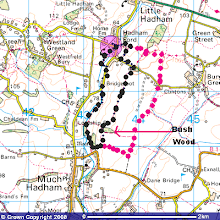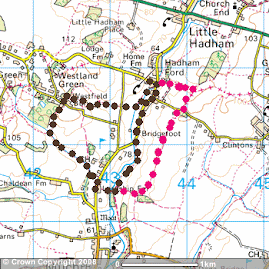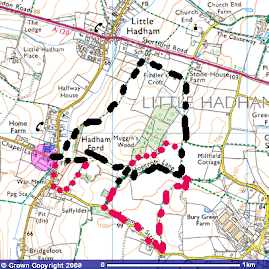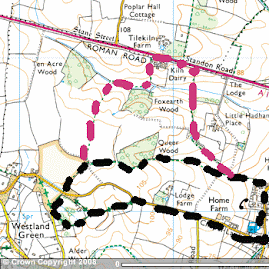With the remarkably high temperatures and no rain until the 27th July, this month has been my best on record for numbers of moths.
On 30th June I had recorded 3309 and by 31st July this total had increased to 8114. Therefore: 4805 moths had been logged in 31 days, an average of 155 insects a night.
In terms of species, 30th June saw me having recorded 171 macros and by the end of July this had risen to 234, 63 new macros whilst micros had risen from 111 to 180, an increase of 69! Remarkable figures for 31 days of running the garden 125W Skinner trap each night. I also ran the portable 15W actinic trap at 9 sites around the parish on 9 nights.
Week 1: Sunday 1st - Saturday 7th July
Cydalima perspectalis was taken on the 1st, a now annual visitor to the trap, having taken the 2nd for Herts in 2012. A Maple pug in the garden was a good moth for that site whilst a
Ostrina nubalis was only my 3rd record, taken in the garden on the 3rd. The 4000th moth for the year, a Dwarf Cream Wave was taken this night, too.
A Dingy shears was a new for the parish records, also garden on the 3rd before a much awaited Small elephant hawkmoth made its first parish appearance on the 6th, again to the garden. On the 7th I took another new for parish record of a
Marasmarcha lunaedactyla, my 327th micro for Little Hadham.
 |
| Small elephant hawkmoth |
 |
| Beautiful Golden Y |
 |
| Scalloped oak |
Week 2: Sunday 8th - Saturday 14th July
The records kept coming, with a new for parish Kent black arches from Westland Green on the 8th, along with 11 moths new for the year. At home that evening a Sycamore was a first for the parish.
The following night a Barred red got on to the parish list and this was followed on the 12th by another new record:
Buccaltrix bechensteinella. This had been attracted to the portable trap set on a footpath that crosses the local golf course and placed under grey willow.
An Uncertain on the 10th was the 5000th moth of the year and a Dark umber from the garden on the 12th was the 350th moth species for me in 2018. On the 13th I was checking field guides to identify another new moth for Little Hadham, a
Metalampra italica. A quick check of county records showed this to be a rapid coloniser of Herts, so not as rare as I had anticipated.
 |
| Kent black arches |
 |
| Lesser spotted pinion |
 |
| Ypsolopha sequella |
Week 3: Sunday 15th - Saturday 21st July
This week began with a new record in the garden trap: Cream bordered green pea and a rarely seen this year,
Nomophila noctuella . The 6000th moth was taken on the 16th, a Riband Wave. On the 20th the garden trap gave up an all time record of 214 moths of 94 species, including just 2 new year records:
Ypsolopha scabrella and lime specked pug. The 21st saw just one new year record, an
Agapeta zoegana.
 |
| Ypsolopha scabrella |
 |
| Agapeta zoegana |
 |
| Nomophila noctuella |
Week 4: Sunday 22nd - Tuesday 31st July
A
Ypsolopha vittella from a local unmanaged woodland (Suffyldes Wood) on the 22nd was another new parish record in a good haul to the heath trap, whilst at home the same night I took a
Pyralis farnalis, another new record. The 400th moth species of the year, a
Aspilapteryx tringipennella was taken on the 23rd as was the 7000th moth for the year, a Dunbar. A twin spotted wainscot was a good surprise new moth on the 25th at home and the following night I ran the trap in an oak and hornbeam wood where
Lathronympha strigana was new for the records. Upon arriving home in the early hours I checked around the garden trap and noted another new one, Gypsy moth. The final new for parish record was last night and probably the best moth of the year, a Gold spot. Not too many records of this well marked insect for Hertfordshire, so a great end to a busy month!
The Gold spot constitutes the 736th moth species for the whole of the parish, a not inconsiderable total, but one that will soon be past 750 I suspect, especially if the warm and dry conditions continue into August and beyond. The 8000th moth, an
Eudonia mercurella came on the 30th
 |
| Ypsolopha vittella |
 |
| Gold spot |
 |
Jersey Tiger, one of 2 taken on the 26th
After the very hectic July, things calmed down a little during August, but still plenty of new records for the year and several new for Little Hadham Parish.
All didn't start well as I left the portable 15W heat trap in a local wood on the first and returned having given a presentation on The Birds of The Camargue to find the trap switched off and overturned, probably a nosy fox or badger. I set it up again, checked the battery life and returned at 5am to find not a lot had flown in during the night. At home, a straw underwing was NFY. An inauspicious start to the month.
The following afternoon was warm and sunny and I had come across a patch of raspberry canes on a now disused allotment. I set the pheremone trap for Raspberry clearwing and left it there for 24 hours. Upon returning, 8 had flown inside the trap. A new record for the parish, my 737th moth species. Several local lepidopterists requested one for their collection.
 |
| One of the 8 Raspberry clearwings |
Another Jersey tiger on the 3rd along with a Canary shouldered thorn and Rosy Minor were both NFY as was a Plutella porrectella, Tawny speckled pug, Cabbage moth, Currant pug and Nephopterix angustella, all from the garden 125W MV Skinner trap.
The 4th brought more records: Webb's wainscot, Mouse moth, Stenoptilia pterodactyla and Hypatima rhomboidella, the latter being new for the parish. All remained the same until the first of many Chrysoteuchia culmella appeared in the garden trap on the 9th. The following night was the coldest since May, just 10 moths, but this did include the first of Agriphila geniculea. Another expected August species arrived on the 13th, a Square spot rustic, followed the following night by the first 6 striped rustic. All as anticipated and nothing too exciting. Centre barred sallow (15th), Flounced rustic (16th) Parapoynx stratiotata (18th) and Cochylis dubitana, also the 18th. The latter being another new species for parish records.
 |
| Plutella porrectella |
 |
| Parapoynx stratiotata |
 |
| Canary shouldered thorn |
 |
| Centre barred sallow |
Moths were beginning to hint at autumn, with regular catches of yellow underwing sp, Setaceous hebrew characters and Square spot rustics in good numbers.
The Heath trap, set on a village green attracted an Acleris emargana on the 19th along with 2 Square spotted clay, which I don't see too many of. This constituted the 250th macro of the year and was followed by finding a Tawny barred angle at home the same night. Again, not a common moth for these parts, this record being my only one for the year.
A Piniphila bifasciana was a new micro for the parish on the 20th whilst the first Lesser yellow underwing arrived on the 22nd, along with another new for the year, a pink barred sallow.
A new for parish Peacock moth was taken on the 23rd
The P. bifasciana became the 740th species for the parish.
An Old Lady and Small dusty wave were NFY, both on the 27th whilst a Pyrausta purpuralis on the 29th became my 10,000 moth recorded for 2018. No other new records for the month left me with totals of 256 macros for the year and 191 micros, with the total moths 10,092.
 |
| Acleris emargana |
 |
| Old Lady |
 |
| Pink barred sallow |
 |
| Piniphila bifasciana |
 |
| Small dusty wave |
 |
| Tawny barred angle |
These numbers are the most I have had up to the end of August and I shall certainly beat last years record of 10,978 moths made up of 282 macro species and 214 micros, totalling 496 species for 2017. This year it looks likely that I shall surpass 500 species in a calendar year for the first time, especially if I find time for some leaf mining visits to the local sites. By the end of August 2018 I had trapped in the garden 199 times and been out to one of 10 chosen sites 97 times. By the end of August I had recorded 34 new species for the parish, a total that should, come December, be close to last year's total of 43 new parish records. Still await a few that I suspect are around along with Death's Head hawkmoth, Clifden Nonpariel, and Crimson Speckled (I can but wish!!)
September continued warm and dry with many opportunities to get the portable 15W Heath trap out to the chosen sites for the year. A feathered gothic on the 2nd to this trap was a NFY as was a Brindled green the following night in Millennium Wood. The same night the first Barred sallow of the year appeared in the garden, one of what was to be a fair few this year. In contrast, I took my, so far, only Rosy rustic of the year on the 5th, along with a new moth for parish records, a Dioryctria abietella.
The following night, the trap on the local golf course gave up Bryotropha affinis and this was followed the next night by a Cacoecimorpha pronubana and leaf mine evidence of Stigmella anomalella in the garden. the C. pronubana was my 200th micro of the year.
A session of leaf mining in Millennium Wood on the 6th gave up 7 new micros for the year, including Phyllonorycter umifoliella as a new for parish records. The first Frosted orange of the year also came to the garden 125W Skinner that night.
On the 9th a brown spot pinion was taken in the garden and this was followed over the next two days by: Brick (Westland Green,) Lyonetia clerkella ((garden,) Lunar underwing (garden,) Sallow (garden) and my only Treble bar for the year, also garden.
A leaf mining visit to Westland Green gave up 10 new micros for the year and two: Ectoedemia heringi and Stigmella continuella were new for parish records.
An Enormia formosana was NFY on the 17th and on the same day a Brindled green constituted my 11,000 moth record for the year. A Deep brown dart on the 18th, and a Black rustic on the 19th were additions to the year list before another leaf mining outing on the 21st to Pig's Green/Caley Wood. This visit added 5 new for year records including Ectoedemia quinquella and Caloptilia alchemiella were new parish moths. The numbers were mounting as the temperature dropped. The 23rd was a particularly chilly, clear night but gave up a Beaded chestnut and the following day, yet another leaf mining expedition, this time to Millennium Wood where 8 NFY species were recorded, of which Stigmella tiliae on lime, Stigmella ruficapitella and Antispila petryi on dogwood were new for the parish. This took my total for parish moths to an impressive 750 species.
The first overnight frost on the 24th didn't stop an Orange sallow becoming my 270th macro for the year. Two nights later an Eudonia angustea was NFY.
The month concluded with a final visit for leaf miners, this time to Alder Wood where 3 micros were added to the year list.
Therefore, by 30th September I had recorded 270 macros and 232 micros in a total for 2018, made up from 11,417 moths.
In early October I received an email with photos attached of a convolvulous hawkmoth taken in the parish on the 26th September, a great record and the first of this species since Geoff Senior recorded one in the late 1990's
Photos:
- Brick
- Brindled green
- Barred sallow
- Sallow
- Black rustic
|








































































No comments:
Post a Comment